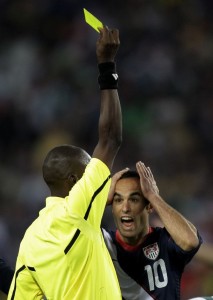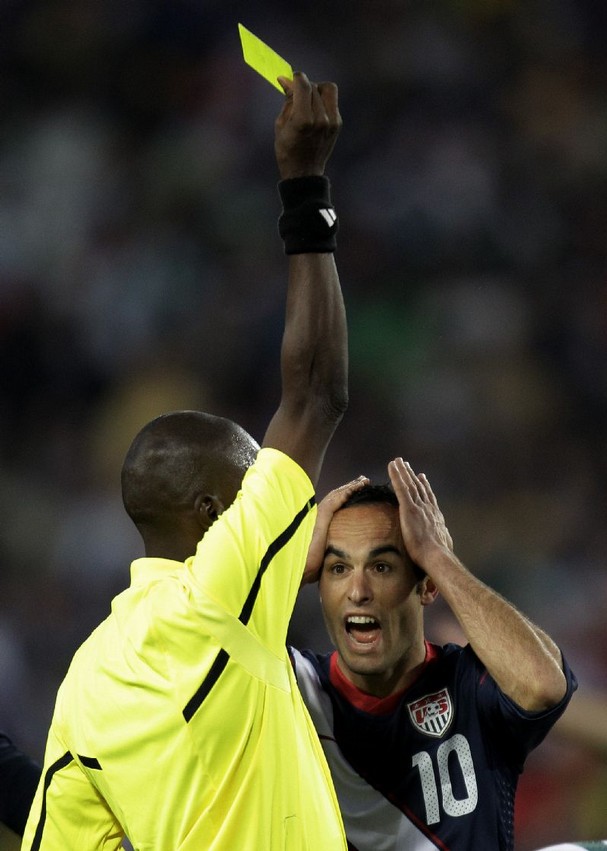Dear Sports Fan,
What are red and yellow cards in soccer? How do they work?
Thanks,
Paul

— — —
Dear Paul,
Cards are soccer’s answer to fouling out in basketball. They are representative of a two stage process that allows a referee to punish misbehaving players with one of the most punitive measures in sports. If a player receives one red card or two yellow cards within the same game, that player is thrown out of the game (“sent off the pitch” or just “sent off” in soccer terms) and his team must play the remainder of the game with one fewer player than they started with. This can mean that a team plays 10 on 11 for 30, 60, or 75 minutes. That’s a long time to play down a man and soccer is already the sport that allows for the fewest substitutions (only two) during a game. It can make for some very tired players.
In World Cup competition, the penalties for receiving cards have implications beyond the game a player receives them in. Any ejection from a game due to a red card or two yellows carries with it an automatic one game suspension that must be served the next time the team plays. Suspensions based on red cards can be lengthened by soccer’s governing body, FIFA. Two yellow cards in different games can also result in a one game suspension if they come between the first game of the tournament and the quarterfinal game. After that, the yellow card counts reset so that any player “carrying” a single yellow card from earlier in the tournament doesn’t have to worry about picking up another in the semifinals and thereby missing the final match. The fact that red and yellow cards carry such enormous penalties probably accentuates soccer’s already dive-happy culture by rewarding players who can trick a referee into giving their opponent a card.
There aren’t really specific fouls that necessitate a red or yellow card, it is up to the referee’s discretion, but there are two key themes which the website football-bible.com does a nice job explaining: violence and “unfairly denying an obvious goal-scoring opportunity.” Violence can come in a few different forms. A player could get a card for being a little too violent intentionally or unintentionally within the course of play, like tripping a player from behind or sliding into an opponent with the studs on his boot facing dangerously up. Likewise, a player could be given a card for being violent in a non-soccer kind of way. Perhaps the most infamous example of this is Zinedine Zidane head-butting an Italian player in the 2006 World Cup Finals. As for “unfairly” denying the opponent an “obvious goal-scoring opportunity,” this could come in the form of tripping a player when he has a clear path to the goal or reaching out and deflecting the ball with your hand as it’s flying towards the goal.
Soccer is not the only sport that uses penalty cards. Wikipedia has a fascinating entry that lists a bunch of sports from volleyball to field hockey to race walking to rugby that uses yellow and red cards as markers of penalties. It also describes the use of other penalty cards like the green card (a lesser warning than a yellow card,) the blue and white cards used in bandy to denote a five or ten minute penalty (editors note: what the hell is bandy,) and the black card used in fencing and badminton for only the worst infringements that require immediate expulsion from play.
In moments of idle reflection, I like to imagine red and yellow cards worming their way out of sports and into everyday life. I dream of being able to halt a disruptive colleague in a meeting by holding up a yellow card. I think it would be great to be able to red card someone who merges badly and have him or her sent off the highway. If you could, how would you use penalty cards in real life?
I hope this has shed some light on the subject of red and yellow cards in soccer for you. Thanks for reading,
Ezra Fischer
To celebrate and prepare for the World Cup in Brazil, Dear Sports Fan is publishing a set of posts explaining elements of soccer. We hope you enjoy posts like Why do People Like Soccer? How Does the World Cup Work? Why Do Soccer Players Dive so Much? and What is a Penalty Kick in Soccer? The 2014 World Cup in Brazil begins on June 12 and ends on July 13.

